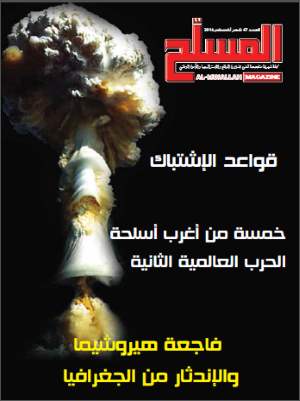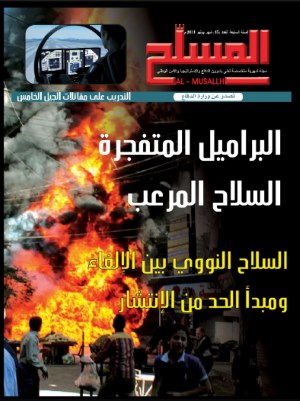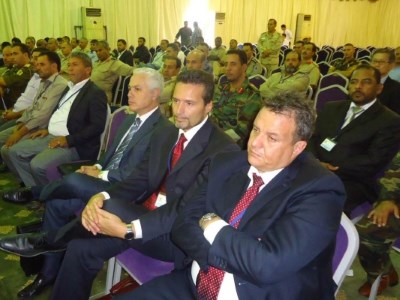Turning Oxidizer Into Fertilizer, UN Experts Help Clear Gharyan Area of Hazardous Substances
Tripoli, 03 April 204 - Nestled in the mountains southwest of the Libyan capital of Tripoli, next to a town best known for its traditional Libyan pottery, is an alien intruder – approximately 600 tonnes of hazardous oxidizer and liquid rocket fuel.
The Libyan Military Air Defence has been consolidating stockpile from various missile sites across the country at a storage site near Gharyan, and this has raised fears among the local population about the health, environmental and safety risks and prompted them to seek assistance in ridding the area of the materiel.
Gharyan’s Local Council has asked the Libyan Military Air Defence in Tripoli to clear the storage site, and the Air Defence in turn requested the assistance of the United Nations. As a result, a team from the UN Support Mission in Libya’s Arms and Ammunition Advisory Section (UNSMIL/AAAS) and Libyan Air Defence personnel carried out a technical inspection of the site on 3 March 2014.
The work at the site, which started nearly a year and a half ago, spanned from safety training to decanting of the liquid fuel and oxidizer. Eventually, the fuel will be burnt and the hazardous oxidizer converted to fertilizer.
The inspection in March was the second such visit. On 11 November 2013, UNSMIL and Libyan Army Air Defence teams inspected the site 32 kilometres south of Gharyan and concluded that it did not pose an immediate danger to the general public. But the Local Council, dissatisfied with the little progress made in addressing the matter, requested another visit.
“The Local Council is concerned that the site poses an environmental and health risk. We determined in November that the fuel is preserved correctly and presented no immediate threat,” said Paul Grimsley, chief of ammunition and weapons at UNSMIL/AAAS. “This latest inspection was a follow-up visit in the presence of (Libyan) Brigadier-General Gumma Al-Abani to reassure the Local Council that this subject is still a priority for the Air Defence,” he added.
During the visit, representatives from Air Defence were accompanied by UNSMIL personnel, members of the Local and Military Councils as well as journalists.
The challenges at the Gharyan site are no different than elsewhere across the country as nearly all of Libya’s Air Defence systems were targeted during the conflict. This resulted in a large number of missiles damaged and leaking both liquid fuel and oxidizer, which when mixed become highly explosive.
Libyan Air Defence personnel have been working in extremely hazardous conditions to remove the fuel and oxidizer for neutralization later. But this work was hampered by lack of equipment and serviceable storage tanks. UNSMIL has been assisting the Air Defence develop their skills in this task, in line with its mandate of supporting Libyan Government efforts to control unsecured arms and related materiel in Libya and counter their proliferation, by working to arrange access, ensure proper management, safe storage, and, where appropriate, effective disposal of arms and related materiel,
The site near Gharyan, sitting on about one square kilometre of land, is a purpose-built storage area containing 16 concrete, well-ventilated buildings. Stored there are about 600 tonnes of oxidizer and of liquid fuel collected from multiple missile sites that were damaged during the 2011 conflict. Any deterioration in the storage conditions of the containers could present an environmental and health risk.
Guards provide security, but the site lacks a perimeter fence, proper accommodation and firefighting equipment. Libyan Air Defence has promised to erect a fence and guard posts, build accommodation for guards and provide firefighting and medical support.
Work started at the site nearly a year and a half ago.
Phase One consisted in providing Chemical Safety Equipment and training. UNSMIL/AAAS, with the support of the United Kingdom, have been instrumental in providing Chemical Safety Equipment and the provision of technical training to Libyan Air Defence personnel who were conducting the task of decanting missile systems damaged during the conflict.
Phase Two, the decanting of the liquid fuel and oxidizers, was carried out by personnel from the Libyan Air Defence and it is halfway through.
Phase Three includes neutralising the liquid fuel and oxidizer, disposal of warheads and rocket motor and the dismantling of the missiles. Equipment is being bought, UNSMIL/AAAS is managing the project, with personnel from Air Defence carrying out the work. The liquid fuel and oxidizer will be neutralised in an environmental friendly manner: the fuel will be burnt and the oxidizer converted to fertilizer.
The entire Gharyan project is expected to be completed in the next 18 to 24 months.












 English
English  العربية
العربية 








